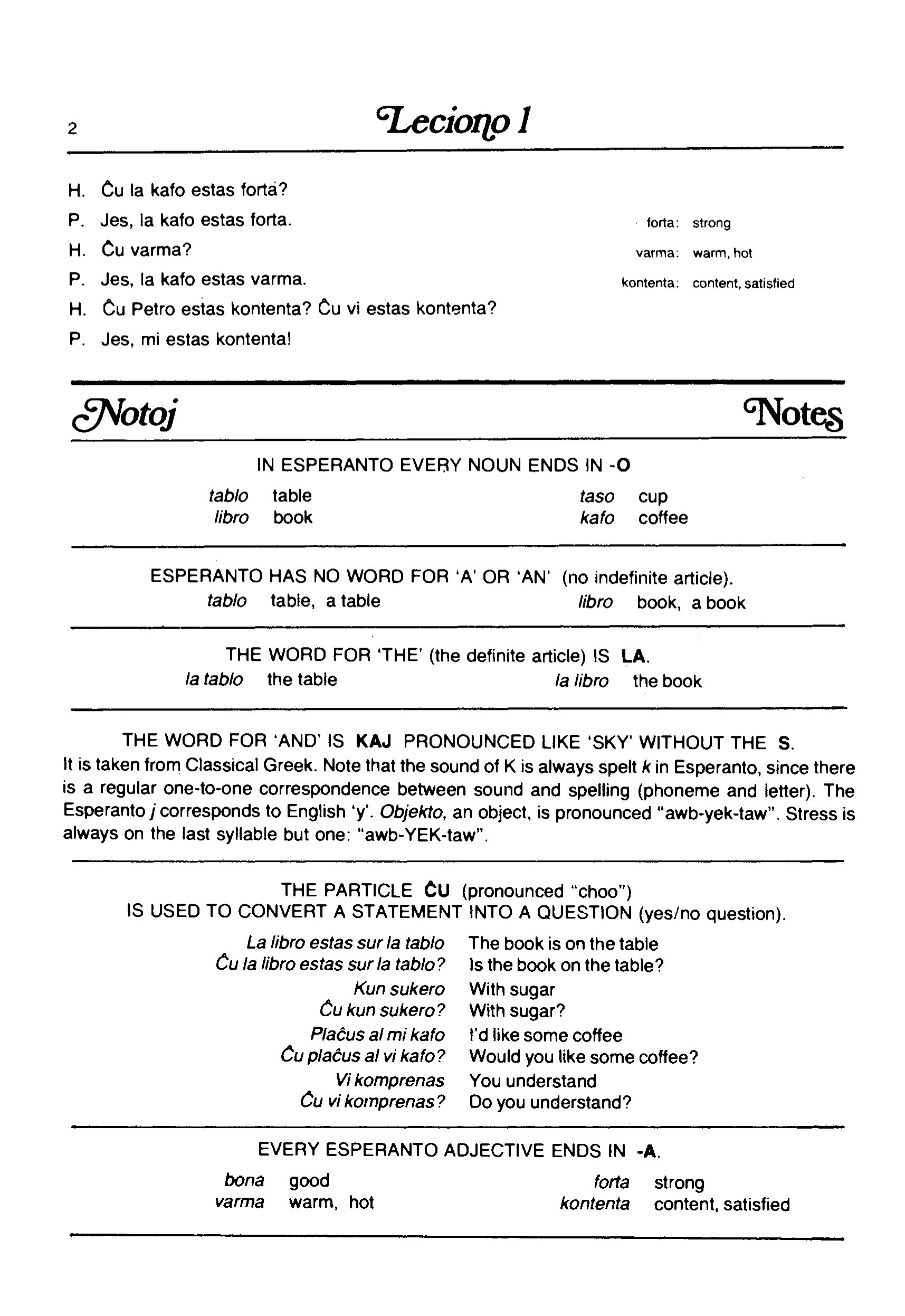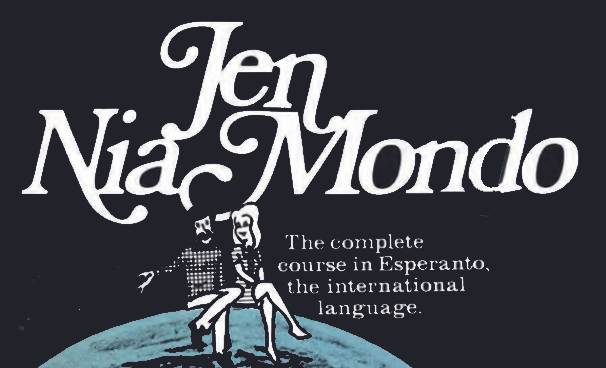
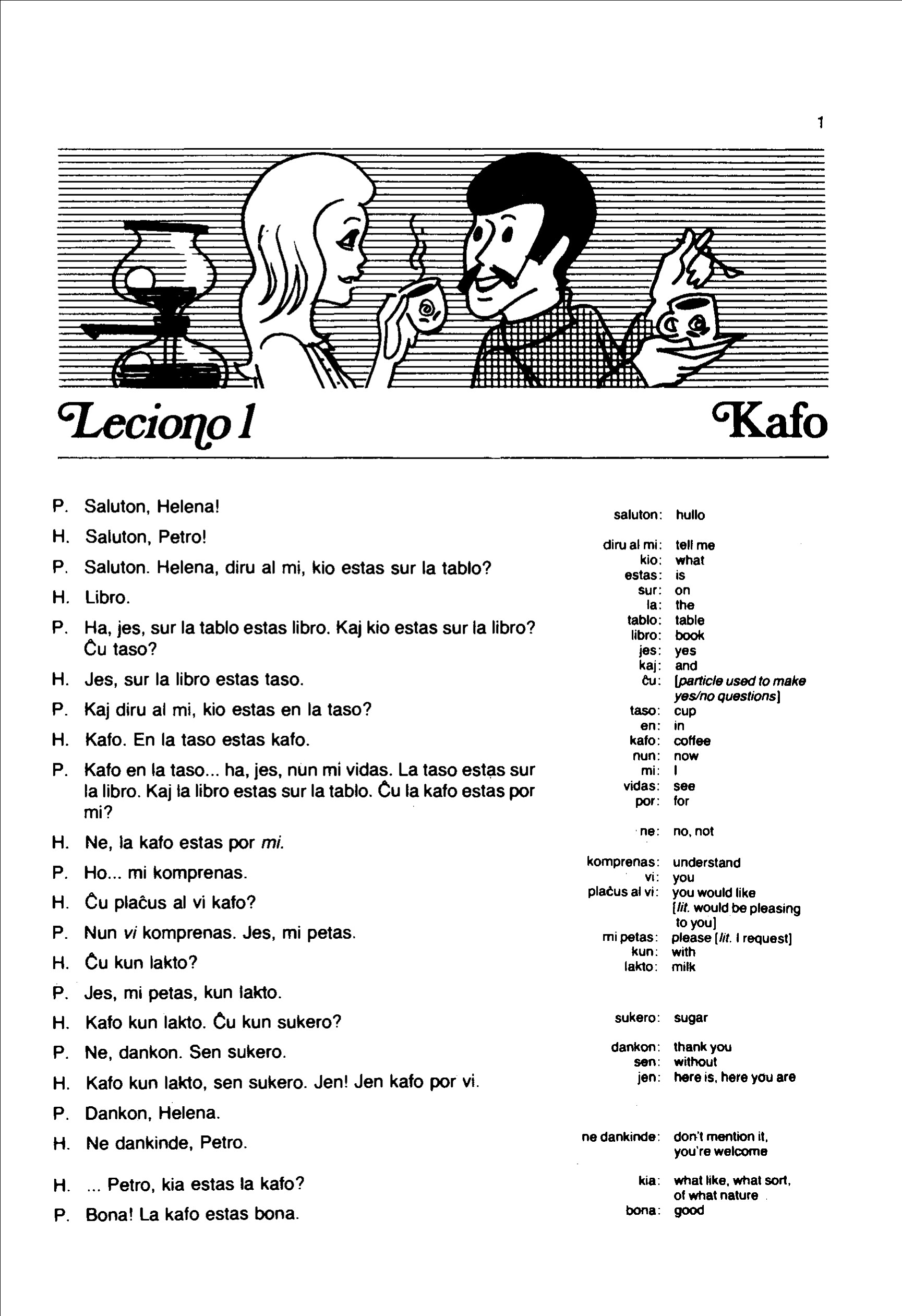
Introduction to the Course
In case you miss the introduction to the course here is a link.
Dialogues
The dialogue for each lesson appears on the top screen. It contains not just the spoken dialogue, but includes important discussion on grammar etc. Points may be made that do not appear elsewhere in the printed lesson. These items are not to be missed. At the end of the spoken session it is suggested that the dialogue should be played again. This is good advice. Occasionally in this on-line edition the final bit of a dialogue may missing, but nothing essential.
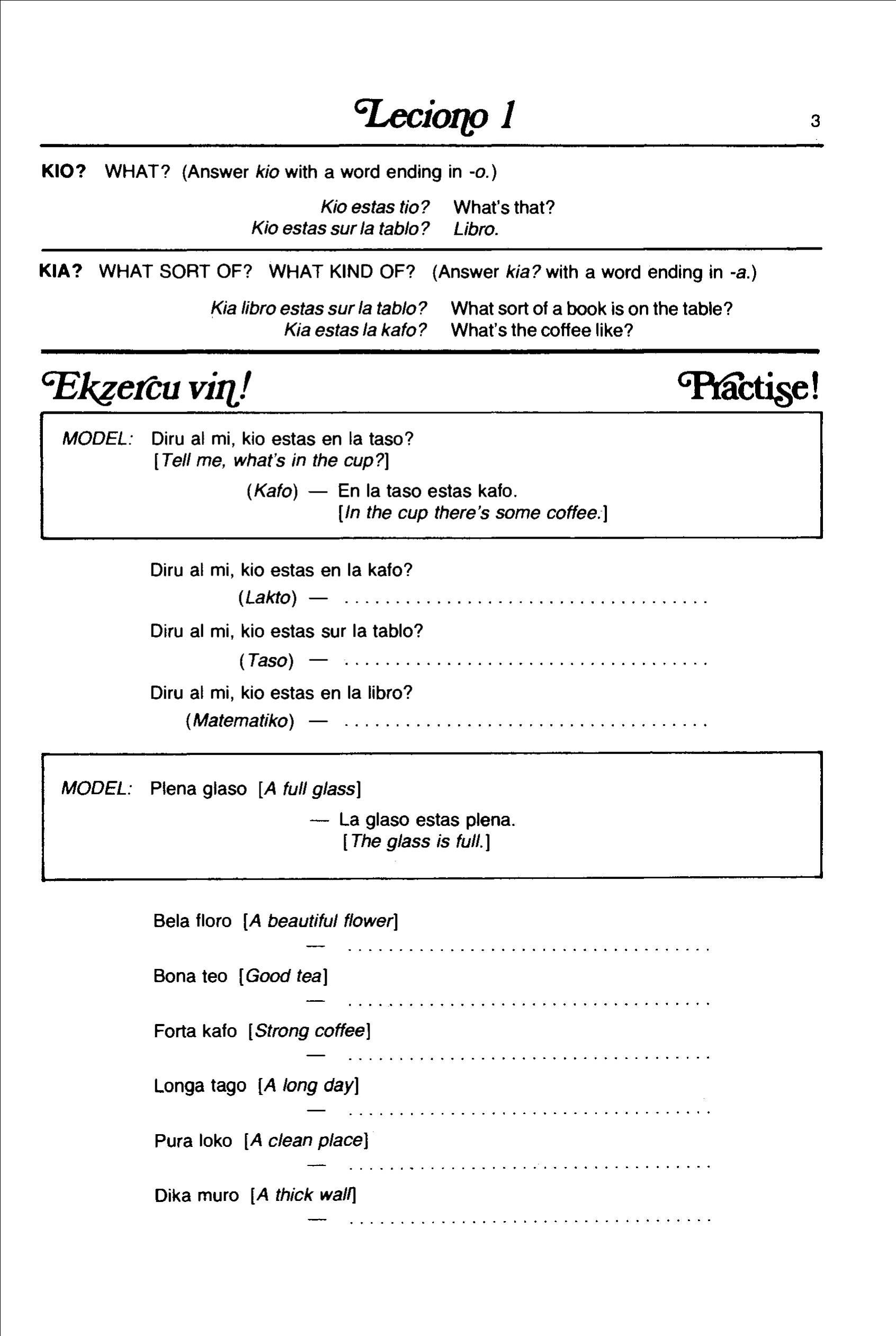
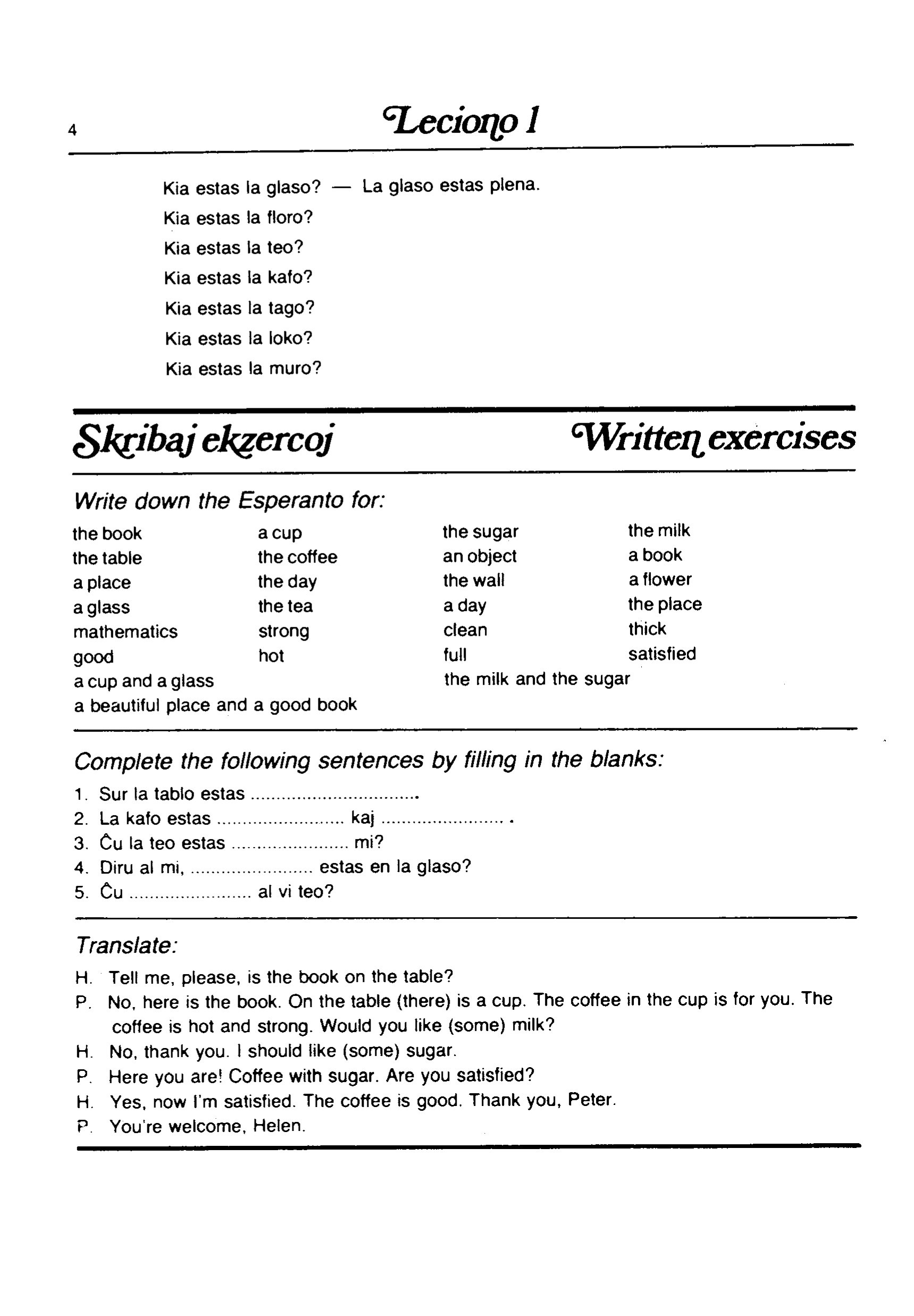

Sample answers are offered below
It will seem a chore to write out ‘answers’, especially at this early stage. However research shows that taking time now to commit pen to paper pays dividends later. It shortens the overall time needed to gain competence.
Esperanto is certainly easier than other languages. It is designed to be easier; but it is also designed to be clear and unambiguous. So you may think some aspects in its grammar are not really necessary, even redundant. For example, in Esperanto nouns and adjectives must have matching endings. French usually does this, but English and Irish do not.
Esperanto is purposely designed as a second language, where clarity of expression and sound have top priority. The risk of misunderstanding is significantly higher when speakers are not using their first languages. However such risks are significantly lower when they use a second language specially designed for this purpose.
Please attempt the exercises before consulting the material below. It is good practice to speak them out aloud. Esperanto only has five main vowel sounds. They should be of medium length, without slurs or slides, as in Italian and in singing exercises!
Leciono 1 Answers
Page 3
Ekzercu vin! – Exercise yourself!
Diru al mi, kio estas en la kafo?
En la kafo estas lakto / Estas lakto en la kafo
Diru al mi, kio estas sur la tablo?
Sur la tablo estas taso / Estas taso sur la tablo
Diru al mi, kio estas en la libro?
En la libro estas matematiko / Estas matematiko en la libro
Bela floro – la floro estas bela
Bona teo – la teo estas bona
Forta kafo – la kafo estas forta
Longa tago – la tago estas longa
Pura loko – la loko estas pura
Dika muro – la muro estas dika
Page 4
Kia estas la floro? – la floro estas bela
Kia estas la teo? – la teo estas bona
Kia estas la kafo? – la kafo estas forta
Kia estas la tago? – la tago estas longa
Kia estas la loko? – la loko estas pura
Kia estas la muro? – la muro estas dika
Skribaj Ekzercoj – Writing Exercises
the book – la libro a cup – taso the sugar – la sukero the milk – la lakto
the table – la tablo the coffee – la kafo an object – objekto a book – libro
a place – loko the day – la tago the wall – la muro a flower – floro
a glass – glaso the tea – la teo a day – tago the place – la loko
mathematics – matematiko strong – forta clean – pura thick – dika
good – bona hot – varma full – plena satisfied – sata
a cup and a glass – taso kaj glaso the milk and the sugar – la lakto kaj la sukero
a beautiful place and a good book – bela loko kaj bona libro
(Note: no word for ‘a’ or ‘an’. Maths is singular!)
- Sur la tablo estas libro
- La kafo estas forta kaj varma
- Ĉu la teo estas por mi?
- Diru alo mi, kio estas en la glaso?
- Ĉu plaĉus al vi teo?
Translate / Traduku
H. Tell me, please, is the book on the table?
Diru al mi, mi petas, ĉu la libro estas sur la tablo?
P. No, here is the book. On the table (there) is a cup. The coffee in the cup is for you. The coffee is hot and strong. Would you like (some) milk?
Ne, jen la libro. Sur la tablo estas taso. La kafo en la taso estas por vi. La kafo estas varma kaj forta. Ĉu plaĉus al vi lakto?
H. No, thank you. I should like (some) sugar (if available).
Ne, dankon. Plaĉus al mi sukero.
P. Here you are! Coffee with sugar. Are you satisfied?
Jen! Kafo kun sukero. Ĉu vi estas kontenta?
H. Yes, now I’m satisfied. The coffee is good. Thank you, Peter.
Jes, nun mi estas kontenta. La kafo estas bona. Dankon, Petro
P. You’re welcome, Helen.
Ne dankinde, Helena.
‘Kio‘ (what) is expecting in response a word ending in ‘o‘, i.e. a ‘noun‘ , a name of an object or thing.
‘Kia‘ (what sort of’, what is it like) is expecting in reply a word ending in ‘a‘, i.e. an ‘adjective’ , a description of an object or thing. Unfortunately English does not have a single word for this query.
Lesson 1 – Vocabulary : consolidated wordlist
al
bon/a
ĉu
dank/o/n!
dik/a
dir/u!
en
est/as
flor/o
fort/a
glas/o
ha!
ho!
jen
jes
kaf/o
kaj
kia
kio
kompren/as
kontent/a
kun
la
lakt/o
libr/o
lok/o
long/a
mi
mur/o
ne
nun
pet/as
plaĉ/us
plen/a
por
pur/a
salut/o/n
sen
suker/o
sur
tabl/o
tag/o
tas/o
te/o
tio
varm/a
vid/as
to(wards), in direction of
good cf bonus
whether (for questions)
thanks!
thick
tell (me), say!
in cf entrance
is, are, am
flower cf floral
strong cf fortify
glass
ha!
ho!
behold, lo!
yes
coffee
and (it’s from Greek!)
what kind or sort of
what (‘whot’!)
understand
content, satisfied
with
the cf ‘la’ in Fr
milk cf lactate
book cf library
place cf location
long
I
wall cf mural
no cf negative
now
request cf petition
would please (if OK)
full cf plenty
for
clean cf pure
hello, salutations!
without cf ‘sans’ in Fr
sugar
on
table
day cf Tag in German
cup
tea
that
warm, hot
see cf video, visual
Note: Do not worry at this stage about any diagonals, strokes or slash characters (/) which split the words in the above lists. This will be explained in a later lesson. However having read above that in Esperanto every noun ends in O then you may be asking is the reverse true. Answer – not entirely but all listed as /o are indeed nouns and similarly for /a and adjectives. Otherwise just learn the words as complete units for now.
